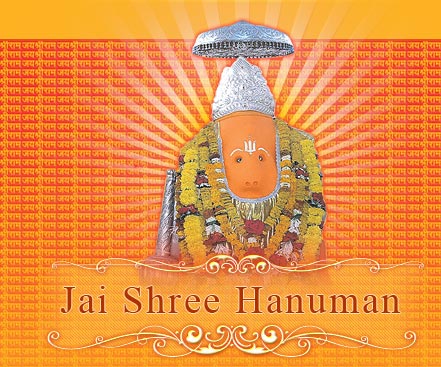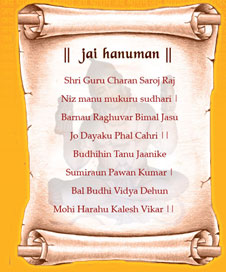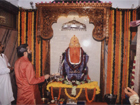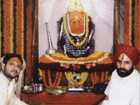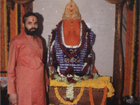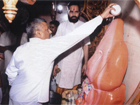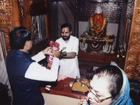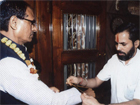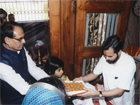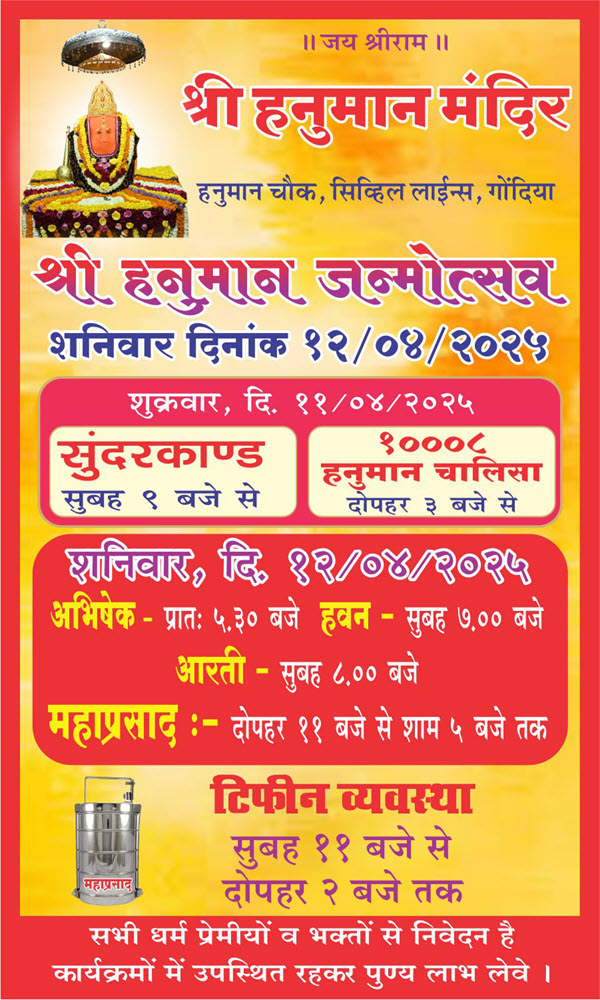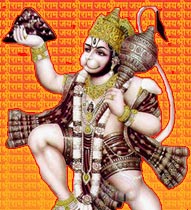
Jai Shree Rama Jai Hanuman
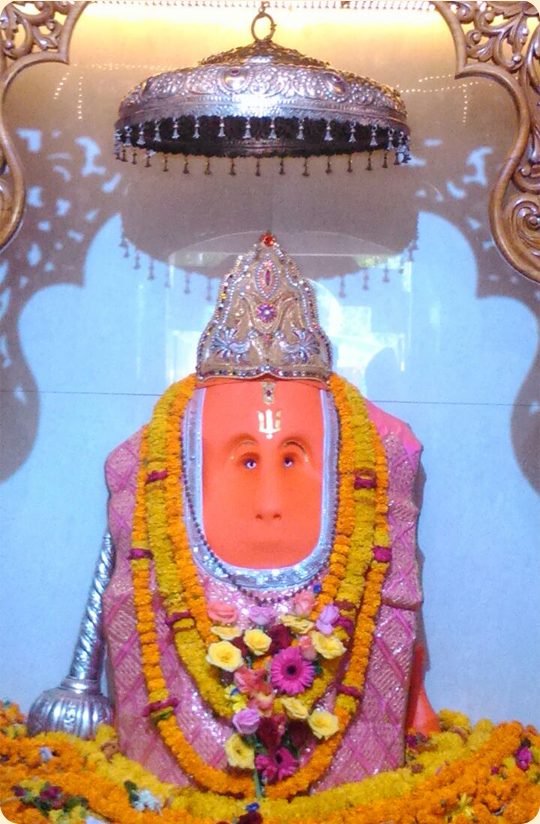
The ancient and sacred temple of Sri Hanumanji has a rich heritage and is situated in the heart of Gondia city, a district place of Maharashtra state. The temple is ancient and was renovated by devotees in 2004, headed by Sri Sudhir Bajaj.
Recent Activities
MP Chief Minister Visit
About Hanuman Jayanti
Hanuman Jayanti is celebrated to commemorate the birth of Hanuman, the monkey god widely venerated throughout India. It is celebrated during the month of Chaitra. Hanuman was an ardent devotee of Lord Rama, and is worshipped for his unflinching devotion to the God. From the early morning, devotees flock Hanuman temples to worship the monkey god. Hanuman Jayanti is an important festival of Hindus. Hanuman is the symbol of strength and energy. Hanuman is said to be able to assume any form at will, wield rocks, move mountains, dart through the air, seize the clouds and rival Garuda in swiftness off light. He is worshipped in folk tradition as a deity with magical powers and the ability to conquer evil spirits. The devotees will visit temples and apply tilak of sindhoor to their foreheads from the Hanumans body as this is considered to be good luck. According to the legend Sita was applying sindhoor to her head, Hanumans Ji questioned why and replied that this would ensure a long life for her husband. Hanuman then smeared his entire body with sindhoor, in an effort to ensure Rama’s immortality.
Hanuman , known also as 'Anjaneya' (son of Anjana) or Maruti (or Maruti nandan), is one of the most popular concepts of devotees of God (bhakti) (devotion to God) in Hinduism and one of the most important personalities in the Indian epic, the Ramayana. His most famous feat, as described in the Hindu epic scripture the Ramayana, was leading an army of monkeys to fight the demon King Ravana. He is also referred to as Bajrang Bali (Sanskrit: Vajranga) because his body was hard like a (vajra). Hanumana is also known as Pavan-Putra (son of Pavana) and Vāyu-Putra because Pavan (the hindu deity of the wind) had played an important role in Anjana's begetting Hanuman as her child.
Birth
In heaven there was a very famous apsara (courtesan, dancing girl) named Punjikasthala. On a certain occasion she insulted one of the rishis. As a result she got a curse that she would be born as a female monkey. After her birth she was named Anjana. Her husband's name was Kesari. Because Anjana had no son, she began to do penance. She gave up eating and drinking. She prayed to god Vayu not only to get her a son, but that he should be powerful and swift, just like god Vayu himself. Vayu answered: "Tathastu", "Amen", "Let it be as you desire." In the morning of the first 14th day of Chaitra in a cave on the Rushyamuk mountain, Anjana gave birth to her son Hanuman. Soon after his birth Hanuman came out of the cave and, as the sun was rising, he flew towards the sun to eat its reddish rays. As he flew towards the sun, Rahu stood in his way. But with a stroke of his tail he pushed Rahu aside. Then came Ketu, but he also was removed, and Hanuman flew ahead towards the sun. Then heaven became worried. Indra mounted his elephant "Airavat", and wondered in his mind, "Who is this extraordinary child going out to eat the sun?" Indra became angry and flung his weapon "vajra" (thunderbolt) on Hanuman, who was caught unawares. He was hit on his left knee, and fell on the top of a high mountain.
Hanuman was born to 'Anjana', a female vanara on the Anjaneri hill in the Brahmagiri hills near Trimbakeshwar, Maharashtra. According to the legend, Anjana was an apsara or a celestial being, named 'Punjikasthala', who, due to a curse, was born on the earth as a female vanara. The curse was to be removed upon her giving birth to an incarnation of Lord Shiva. It is also said that Hanuman was born on Anjaneya Hill, in Hampi, Karnataka, near the Risyamukha mountain on the banks of the Pampa, where Sugreeva and Sri Rama met. There is a temple that marks the spot. One more place associated with birth of Hanuman is Aanjan. Aanjan is a small village about 18 km away from Gumla via Toto. The name of the village has been derived from the name of goddess Anjani, mother of Mahaveer Hanuman. Aanjani Gufa(cave) is at 4 km from the village upon a hill. Here mother Anjani used to live. Many objects of archeological importance obtained from this place has been placed at Patna Museum. There is an idol of mother Anjani with Hanuman in her lap near Anjani Gufa.
Along with Kesari, her husband, Anjana performed intense prayers to Shiva to beget Him as her Child. Pleased with their devotion, Shiva granted them the boon they sought.Hence, the Hanuman is also known as "Maharudra" because he was born out of the boon given to Anjana by the Shiva who is also known as Rudra. The Valmiki Ramayana, (Yuddha Kanda) states that Kesari is the son of Brihaspati and that Kesari also fought on Rama's side in the war against Ravana.
Different stories are told explaining Hanuman's birth.
One is that at the time that Anjana was worshipping Lord Shiva, elsewhere, Dasharatha, the king of Ayodhya, was performing the Putrakama Yagna in order to have children. As a result, he received some sacred pudding, payasam, to be shared by his three wives, leading to the births of Rama, Lakshmana, Bharata, and Shatrughna. By divine ordinance, a kite snatched a fragment of that pudding and dropped it while flying over the forest where Anjana was engaged in worship. Vayu, the Hindu deity of the wind, delivered the falling pudding to the outstretched hands of Anjana, who consumed it. Hanuman was born to her as a result.
Being Anjana's son, Hanuman is also called Anjaneya (pronounced Aanjaneya), which literally means "arising from Anjani".
Sri Aurobindo states that "vanara" does not refer to "monkey": "Prajapati manifests as Vishnu Upendra incarnate in the animal or Pashu in whom the four Manus have already manifested themselves, and the first human creature who appears is, in this Kalpa, the Vanara, not the animal Ape, but man with the Ape nature", i.e. primitive man such as Homo erectus.
Hanuman, in one interpretation, is also considered as the incarnation of Shiva or reflection of Shiva also known as Rudra. Others, such as followers of Dvaita consider Hanuman to be the son of Vayu or a manifestation of Vayu, the god of wind. When Ravana tried to enter the Kailash (the abode of Shiva) called Lord Shiva "a monkey". Lord Shiva in return cursed Ravana that a monkey would burn his Lanka. Shiva took the form of Hanuman.
References to Hanuman in classical literature could be found as early as those of 5th to 1st century BC in Panini's Astadhyayi, Abhiseka Nataka, Pratima Nataka, and Raghuvamsa (Kalidasa).
